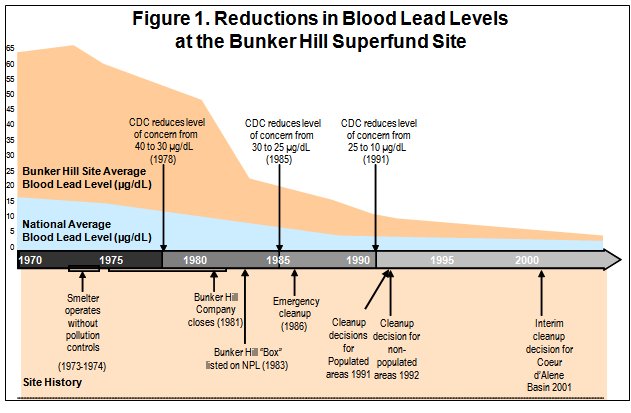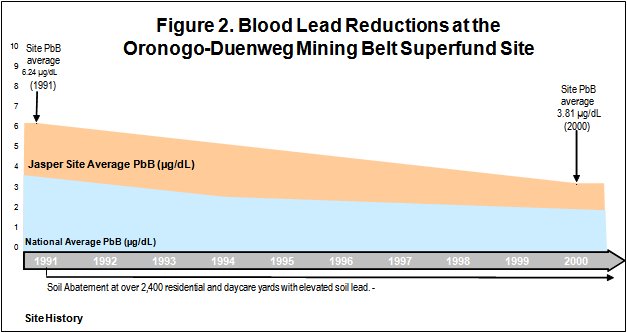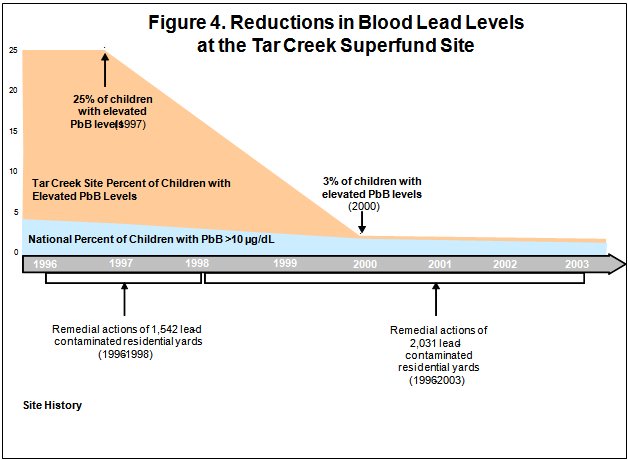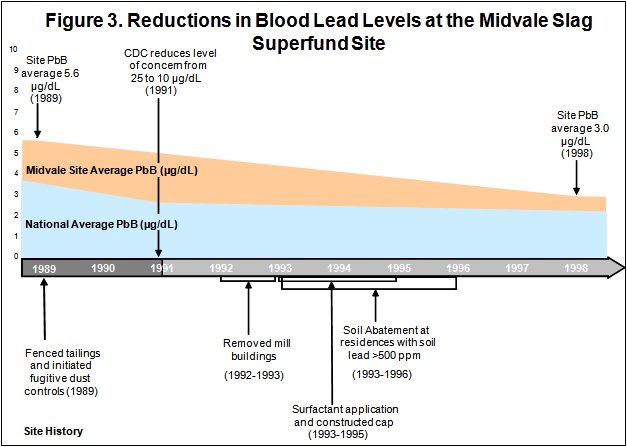Lead at Superfund Sites
On this page:
- What is the issue and why should people care?
- What is EPA doing about it?
- What are others doing about it?
- What can you (as a person or as an organization) do about it?
- Other resources to learn more
- Examples of Superfund Site cleanups
What is the issue and why should people care?
Lead contamination at Superfund sites presents a threat to human health and the environment. Lead, a naturally occurring element, can be harmful to humans (particularly children) when ingested or inhaled. Lead is a common environmental contaminant at Superfund sites across the country. To learn more about the effects of lead exposure and EPA's role in reducing the presence of lead in the environment, visit EPA's Lead Web page.
What is EPA doing about it?
EPA response actions at Superfund sites address a release or threat of release of a hazardous substance such as lead into the environment. EPA response actions seek to limit the risk of site-related lead exposure. The Agency conducts risk assessments and considers site-specific factors to design response actions that reduce the likelihood of exposures to the most vulnerable populations, including children and pregnant women.
To help in determining appropriate response actions, EPA uses the Integrated Exposure Uptake Biokinetic (IEUBK) model and the Adult Lead Methodology (ALM) to estimate the concentration of lead in the blood of children, pregnant women and their developing fetuses who might be exposed to lead-contaminated soils. The level to which EPA remediates lead contamination at Superfund sites is guided by risk assessors' application of the IEUBK model and the ALM for site-specific scenarios to estimate blood lead concentrations. These findings help EPA estimate possible adverse health effect exposures.
EPA has convened a workgroup to assist in the use of the IEUBK model and the ALM:
The workgroup addresses risk assessment and risk management issues.
Please refer to the Software and Users' Manuals page as well as the Guidance page for important documents related to the TRW, the IEUBK model, the ALM and risk assessment.
What are others doing about it?
To learn more about the efforts of other federal agencies, states, counties and organizations to prevent lead exposure, visit EPA's Other Lead Links page.
What can you do about it?
Education is the key. Learn more about protecting your family from exposure to lead.
Other resources to learn more
EPA’s Related Links page provides other resources to learn more.
Examples of Superfund Site Cleanups
Superfund cleans up contaminated media, such as soil, to protect human health and the environment. Lead can be toxic when ingested or inhaled and blood lead levels can be used as a measure of exposure. Blood lead levels measured before and after cleanup confirm that exposure to lead has been reduced. The process of cleanup and changes in blood lead levels can be better understood by examining site cleanup work.
Below are a few examples of Superfund cleanup actions that show blood lead level reductions among children. At each of these sites, blood lead testing took place before and during cleanup. The table below provides additional information on the cleanups.
| Site Name | City | State | Sources of Contamination |
|---|---|---|---|
| Vasquez Boulevard and I-70 | Denver | CO | Historic smelting operations |
| Bunker Hill Mining & Metallurgical Complex | Smelterville | ID | Historic mining and smelting operations (More information on blood lead levels) |
| Cherokee County | Galena | KS | Historic mining operations |
| Big River Mine Slag/St. Joe Minerals Corp. | Desloge | MO | Historic mining operations |
| Madison County Mines | Fredericktown | MO | Historic mining operations |
| Oronogo-Duenweg Mining Belt | Joplin | MO | Historic mining and smelting operations (More information on blood lead levels) |
| East Helena Site | East Helena | MT | Historic smelting operations |
| Omaha Lead | Omaha | NE | Historic smelting operations |
| National Zinc Corp. | Bartlesville | OK | Historic smelting operations |
| Midvale Slag | Midvale | UT | Historic smelting operations (More information on blood lead levels) |
| Tar Creek (Ottawa County) | Ottawa County | OK | Historic mining operations (More information on blood lead levels) |
| RSR Corporation | Dallas | TX | Historic smelting operations |
| Eureka Mills | Eureka | UT | Historic mining operations |




